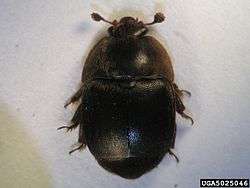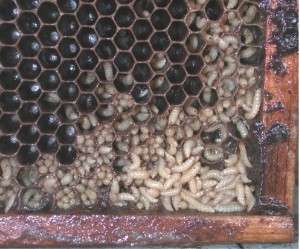Small hive beetle
| Small hive beetle | |
|---|---|
 | |
| Scientific classification | |
| Kingdom: | Animalia |
| Phylum: | Arthropoda |
| Class: | Insecta |
| Order: | Coleoptera |
| Family: | Nitidulidae |
| Genus: | Aethina |
| Species: | A. tumida |
| Binomial name | |
| Aethina tumida Murray, 1867 | |
The small hive beetle (Aethina tumida) is a beekeeping pest.[1]
Endemic to sub-Saharan Africa, the small hive beetle, Aethina tumida was first discovered in the United States in 1996 and has now spread to many U.S. states including, Georgia, Florida, South Carolina, North Carolina, California, Michigan, Pennsylvania, New Jersey, Ohio, Illinois, Indiana, Minnesota, Maryland, Missouri, New York, Connecticut, Rhode Island, Virginia, Texas, and Hawaii. The movement of migratory beekeepers from Florida may have transported the beetle to other states. Recent findings also indicate transport of the beetles in packages.
Internationally, the Small Hive Beetle has spread to Australia being first identified at Richmond, NSW in 2002. Subsequently it has affected many areas of Queensland and New South Wales.[2] It is speculated that a combination of importing queens from other countries and beekeepers moving their hives has caused the spread.[3]
In Canada, the small hive beetle has been detected in Manitoba (2002 and 2006), Alberta (2006), Québec (2008, 2009), Ontario (2010) and British Columbia (2015). In the Prairie Provinces, measures were taken to control the pest and small hive beetles failed to establish a population. It is still to be determined whether the small hive beetle has been able to establish a resident population in Ontario or Québec.[4] In the summer of 2015 the discovery of a number of adult beetles as well as one infestation in all stages of brood in British Columbia's Fraser Valley triggered a temporary quarantine.[5][6]
The SHB has now reached the southern Philippines in southern Mindanao island and there is great concern that it will spread through the country if hives and bees are moved from the southern Mindanao area where the beetle has already been identified.
The small hive beetle can be a destructive pest of honey bee colonies, causing damage to comb, stored honey and pollen. If a beetle infestation is sufficiently heavy, they may cause bees to abandon their hive. Its presence can also be a marker in the diagnosis of Colony Collapse Disorder for honey-bees. The beetles can also be a pest of stored combs, and honey (in the comb) awaiting extraction. Beetle larvae may tunnel through combs of honey, feeding and defecating, causing discoloration and fermentation of the honey.
Life history
Aethina tumida was previously known only from the sub-Saharan regions of Africa where it has been considered a minor pest of bees. The life cycle information is known primarily from studies in South Africa.
The small hive beetle is a member of the family of scavengers or sap beetles. The adult beetle is dark brown to black and about one-half centimeter in length. The adults may live up to 6 months and can be observed almost anywhere in a hive, although they are most often found on the rear portion of the bottom board of a hive. Female beetles lay irregular masses of eggs in cracks or crevices in a hive. The eggs hatch in 2–3 days into white-colored larvae that will grow to 10–11 mm in length. Larvae feed on pollen and honey, damaging combs, and require about 10–16 days to mature. Larvae that are ready to pupate leave the hive and burrow into soil near the hive. The pupation period may last approximately 3–4 weeks. Newly emerged adults seek out hives and females generally mate and begin egg laying about a week after emergence. Hive beetles may have 4–5 generations a year during the warmer seasons.
Damage to colonies and stored honey

The primary damage to colonies and stored honey caused by the small hive beetle is through the feeding activity of the larvae. Hives and stored equipment with heavy infestations of beetles have been described as a mess. A summary taken from various reports of damage caused by these beetles is listed below:
Larvae tunnel through comb with stored honey or pollen, damaging or destroying cappings and comb. Larvae defecate in honey and the honey becomes discolored from the feces. Activity of the larvae causes fermentation and a frothiness in the honey; the honey develops a characteristic odor of decaying oranges. Damage and fermentation cause honey to run out of combs, creating a mess in hives or extracting rooms. Heavy infestations cause bees to abscond; some beekeepers have reported the rapid collapse of even strong colonies.
Control
The small hive beetle is considered a secondary pest in South Africa, and, as such, has not been the subject of major control efforts. The beetle is most often found in weak or failing hives and rarely affects strong hives. However, differences in the housecleaning traits of the bees found in South Africa and the U.S. may mean very different responses to the beetles. Some early reports from Florida and South Carolina suggest the beetles may be more damaging there than in Africa. PDB (paradichlorobenzene) has been used for protecting empty stored combs. Coumaphos bee strips (Bayer Corporation) have been approved for use in hives for the control of small hive beetles in some states under an emergency registration.
Biological control through beneficial soil nematodes specific to the SHB is also effective.Nematodes are microscopic roundworms found living naturally in most soils. Many species of nematodes exist and each has a peculiar function in the environment. Also they pose no threat to the environment and are exempt from registration and regulation by EPA and FDA.
Beneficial nematodes are used by applying them to the soil while suspended in water. They may be applied as a pressurized spray or simply poured from a watering can. Nematodes applied to soil burrow downward in search of insect pests. Once found, nematodes enter the body of the insect and release a powerful bacterium which quickly kills the pest. Released bacteria dissolve the internal tissues of the insect which becomes food for nematode growth and development. Matured nematodes then mate and lay eggs to produce more nematodes within the dead insect. Several such generations may occur over just a few days. After the inside of an insect is consumed, tiny infective stage nematodes leave the dead insect shell and begin searching for more pests. As many as 350,000 nematodes may emerge from a single dead insect after only 10-15 days. Numbers depend on insect size.
The most effective control against small hive beetle is maintaining colony strength. Coupled with minimizing empty frames of comb, this will all but eliminate the chances of colony failure.
There are also several traps currently on the market. The more effective ones are the Beetlejail Baitable, Hood Trap, the Freeman Beetle Trap, the West trap, the Australian, AJ's Beetle Eater[7] and the Beetle Blaster.[8] All these traps use non-toxic oil to suffocate the beetles. This allows beekeepers to avoid having toxic chemicals in their beehives.
To preserve the beetles for identification, it is recommended to submerse the beetle in a container or methylated spirits or vinegar. This will kill live beetles.
Regulations
In New South Wales (Australia), infestation of hives by Small hive beetle is notifiable as a honey bee pest under the Stock Diseases Act 1923. The maximum penalty for failing to notify is $11,000.[9]
Distribution
National Agricultural Pest Information System (NAPIS) May 2005, accessed Sep 2005
References
- ↑ Hood, Michael (2004). "The small hive beetle, Aethina tumida: a review" (PDF). Bee World. 85 (3): 51–59.
- ↑ Rhodes, J; B.McCorkell (September 2007). "Small Hive Beetle Aethina tumida in New South Wales Apiaries 2002-6" (PDF). NSW Department of Primary Industries. Retrieved 2010-11-01.
The purpose being to record the spread of... (SHB) within NSW since its identification at Richmond, NSW, in 2002.
- ↑ Neumann, Peter; Elzen, Patti J. (2004). "The biology of the small hive beetle (Aethina tumida, Coleoptera: Nitidulidae): Gaps in our knowledge of an invasive species". Apidologie. 35 (3): 229–247. doi:10.1051/apido:2004010.
- ↑ "Small Hive Beetle in Ontario". 2011-04-07. Retrieved 2012-05-22.
- ↑ Lee, Jeff. "Beetle pest found in B.C. bee hive". The Vancouver Sun. The Vancouver Sun. Retrieved 23 December 2015.
- ↑ Lee, Jeff. "First Small Hive Beetle Infestation With Larvae Found In B.C.". Honey Bee Zen. Retrieved 23 December 2015.
- ↑ Ellis, Jamie. "Pests and Disease Videos". Dr. Jamie Ellis discusses the Small Hive Beetle. Honey Bee Research & Extension Laboratory University of Florida Entomology & Nematology Department. Retrieved 2010-10-31.
Another trap that has become increasingly popular is AJ's Beetle Eater...
- ↑ Hood, Michael Integrated Pest Management Dept. of Entomology, Soils, and Plant Sciences Clemson University, Clemson, South Carolina June 2010
- ↑ Rankmore, Mick (2007). "NSW Apiaries Act 1985 - a guide to the main sections" (PDF). NSW Department of Primary Industries. Retrieved 2010-11-01.
Sources
| Wikispecies has information related to: Small hive beetle |
| Wikimedia Commons has media related to Aethina tumida. |
- The Small Hive Beetle Department of Entomology, Virginia Tech, June 1999, accessed Sep 2005
- The Small Hive Beetle: A serious threat to European apiculture The Food and Environment Research Agency, UK Nov 2010, accessed Dec 2011
- Somerville, Doug Study of the small hive beetle in the USA Rural Industries Research and Development Corporation, Jun 2003, accessed Dec 2011
- Ellis J, Ellis A,. (2010). Small hive beetle, Aethina tumida (Murray). Featured Creatures. 6 July 2010.
- Rhodes, John; Livestock Officer, Tamworth Small hive beetle - an in-hive control device using diatomaceous earth (2008)
- Annand, Nicholas Small hive beetle management options NSW DPI Australia, March 2008, accessed Dec 2011
- HawaiiNewsNow Bee parasite the latest threat to Hawaiis honey industry May 5, 2010